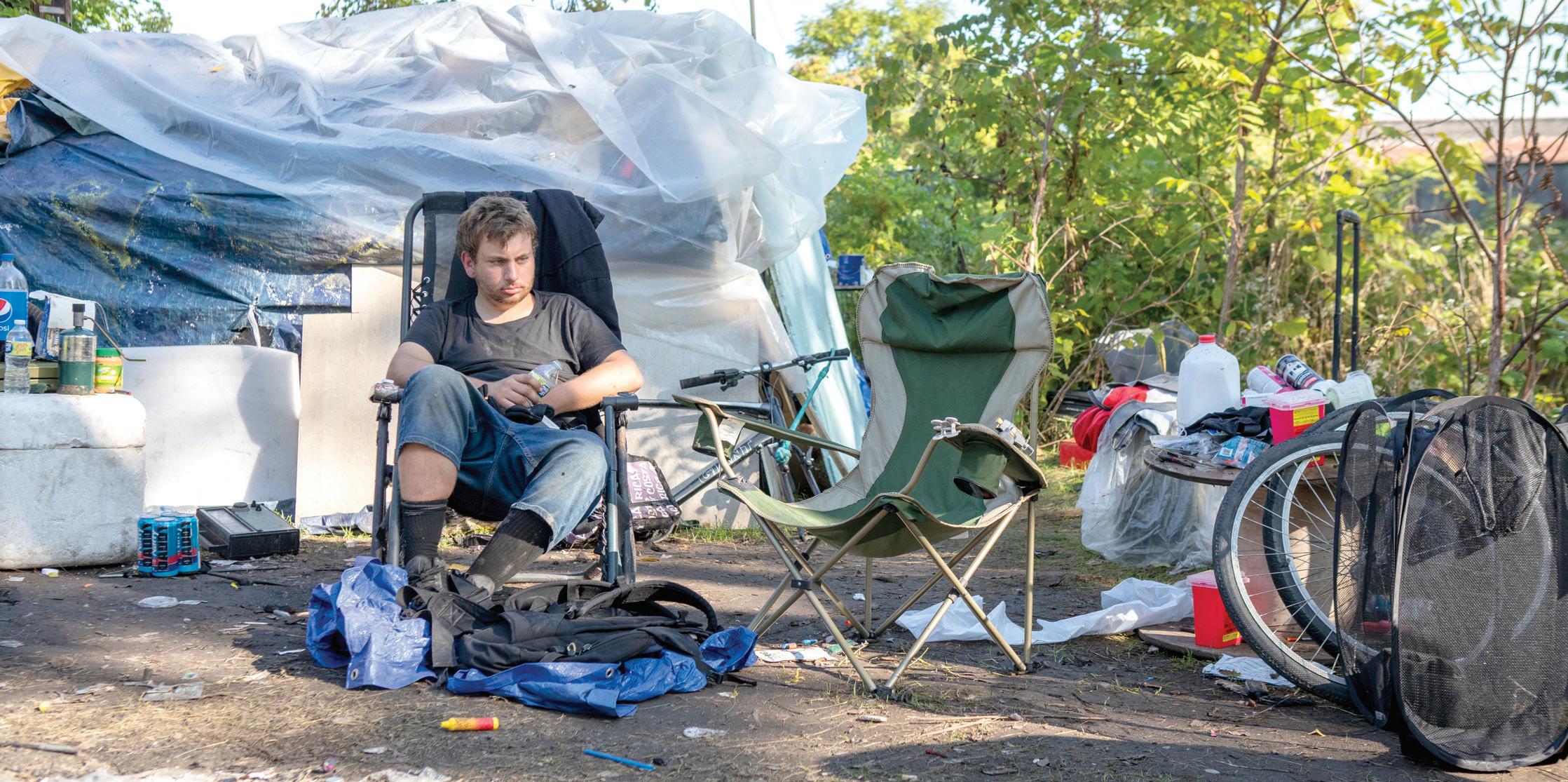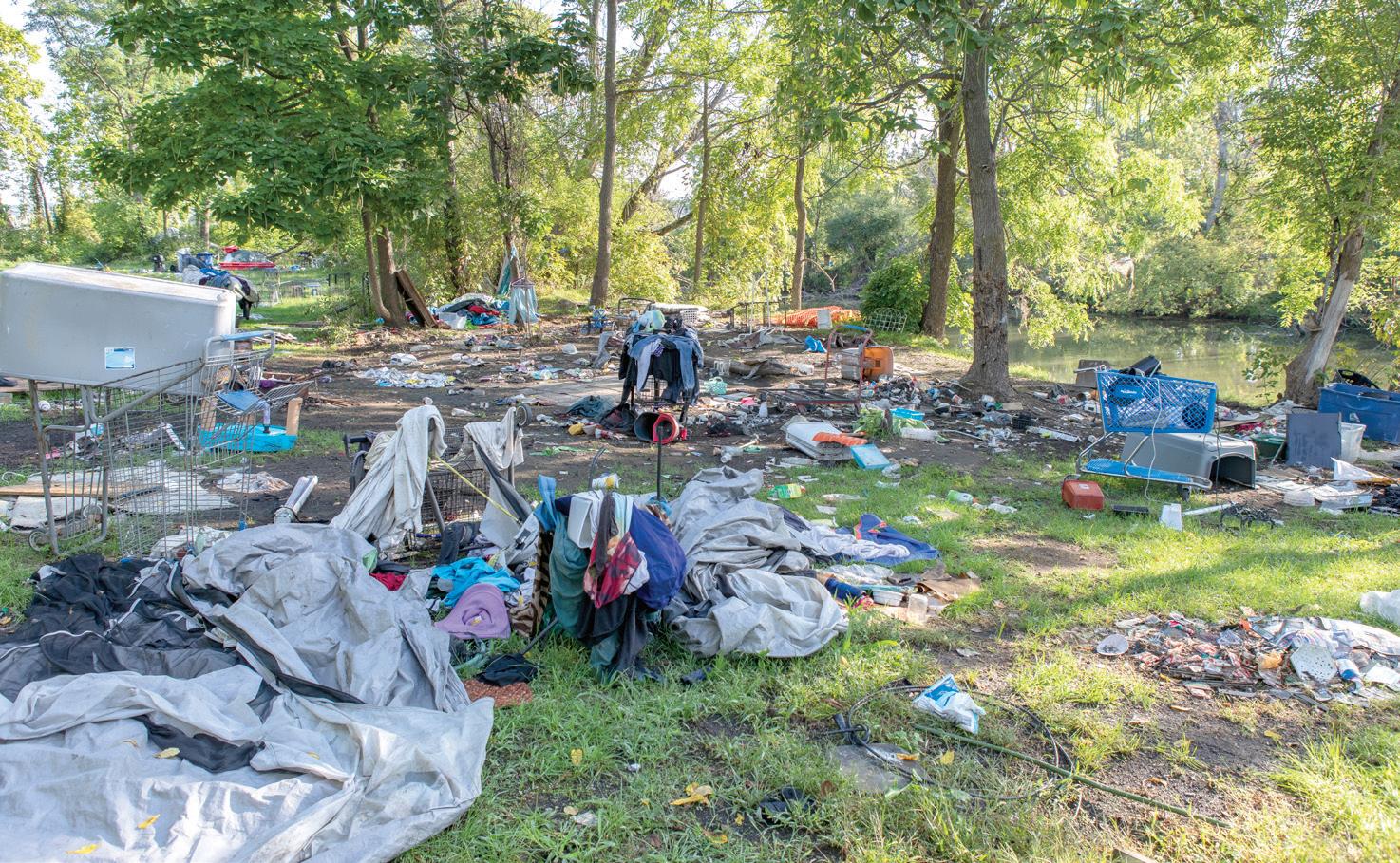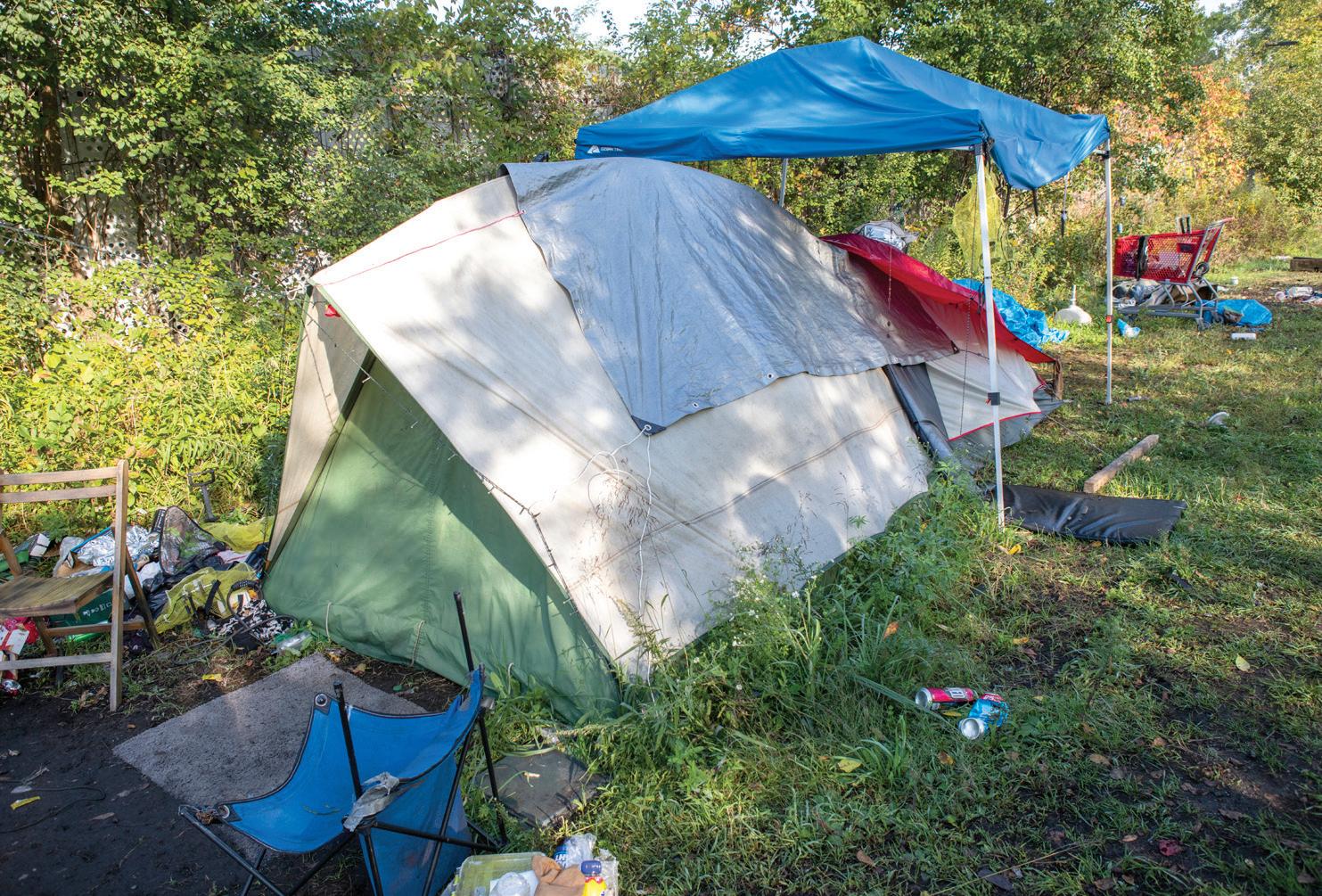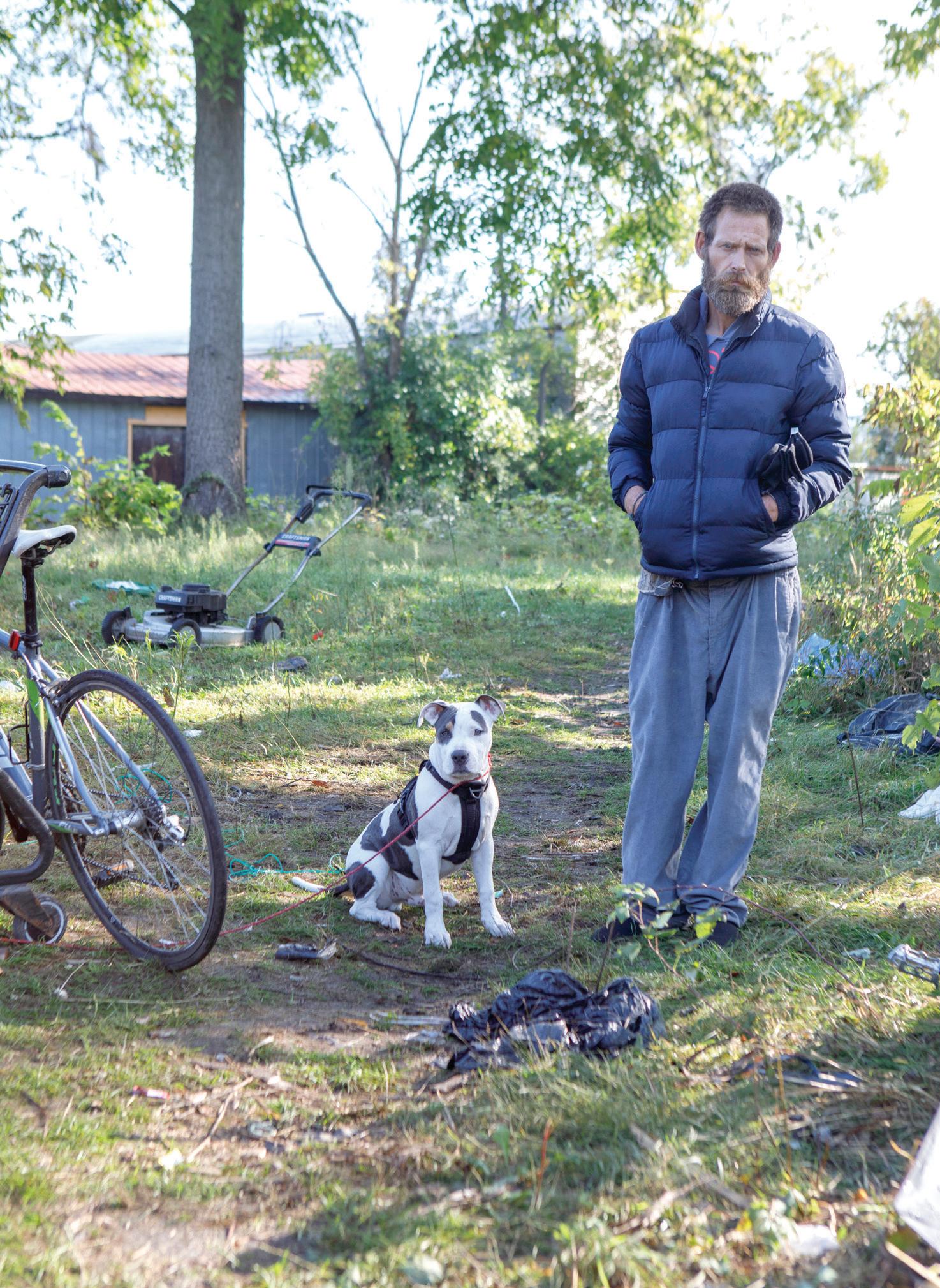
14 minute read
DEVELOPMENT AND THE HOMELESS
from October 12, 2022
by Ithaca Times
WEST END PROJECTS CHALLENGED BY HOMELESSNESS
An Ithaca Times Special Report, Part I
Advertisement
What happens in Ithaca’s West End in the next year can de ne what kind of city Ithaca will be going forward. We pride ourselves on being a community that cares about those in need, and we’re also a city that has been an island of vibrancy and growth in a region that has not been so fortunate. As development has spread from downtown and Collegetown to the West End, it has come up against a part of our community we’ve o en pretended didn’t exist, or chosen to ignore: the homeless and underserved, who have inhabited part of that area for many years. Our desire to be our best selves and care for our neighbors has led to that population growing and changing, and that is now a ecting many of the residents and businesses in the West End, who are experiencing a level of crime and vagrancy that impacts quality of life. How we deal with this subject is perhaps the most important issue Ithaca has faced since the construction of the Commons in 1974. ere has been considerable new development in Ithaca’s West End and Waterfront in the last couple of years, with more in the pipeline. e City’s stated goals of increasing density, encouraging compact mixed-use development and the building of new a ordable housing are visibly becoming a reality. Yet, the West End and the Waterfront have always been somewhat separate from the rest of the city, and there are issues speci c to that area that may prove to be obstacles to realizing those goals. e West End, part of the city’s First Ward, is generally the area bounded somewhere west of Washington Park, east of West Hill, probably south of the Hangar eater and north of the Southwest Natural Area behind Home Depot. Contained therein is the Waterfront District, described as “non-park land between the Flood Control Channel and Route 13 and includes Inlet Island.” In the language of the urban planner, the West End connects the West State/MLK Street corridor to the Waterfront District. It has been home over the years to scores of businesses, industries, railroads, the Erie/Barge Canal, warehouses, hotels, restaurants, middle-class and working-class homes, desperately-poor squatters, an unhoused population, and the city dump. Historically, it has never been the Ithaca of Cornell University, stately homes, or the wealthy families. e banks and fancy hotels, the Tremans, the McGraws, the Sages, the Newmans—all that has always been on the eastern side of town and up on East Hill.
By Charley Githler
Residents and those who work with them say the population of the Jungle has gotten younger. (Photo: Josh Baldo)
Discussions about how to best use the Waterfront go back decades, and there have been numerous studies since the 1970s of the development possibilities in the area. Potentially prime real estate, it has long been seen as an underutilized area with the capability of being turned into something of a jewel in Ithaca’s crown. We’ll be exploring the status of development in the West End and Waterfront in Part I of this story and looking at the historical context of the challenges to that development in Part II, next week.
Responsible city planning starts with a Comprehensive Plan, and e City of Ithaca’s most recent Comprehensive Plan was adopted in 2015. Essentially a tool for planning, growth and development, it addresses issues related to the compatibility of various uses of land, management of natural resources, preservation of historically signi cant lands and structures, and addressing infrastructure needs. It’s a formal document and was adopted as an o cial policy guide. Some of the overarching themes in Ithaca’s plan are to increase density, create transportation and housing options that will reduce commuter tra c, and encourage compact mixed-use development in the coming years. More speci c to the West End and Waterfront district are the goals of creating dense, walkable, and ecologicallysensitive spaces that have a positive impact on the area while increasing the city’s tax base. Supplemental to the Comprehensive Plan, and created using much the same process, are plans for speci c areas within the city, and there is one for Ithaca’s Waterfront area. Both are available online through the city’s website.
On the one hand, there are “many vacant and underutilized parcels...that provide a high potential for redevelopment,” but the plans also describe signi cant challenges to development in the West End and Waterfront areas. One of those challenges is the high volume of vehicle tra c. ree busy state roads—Routes 79, 89, and 96 — converge on the west side of the Inlet, and three main city streets—State/MLK, Seneca, and Bu alo—bring tra c from downtown to the east side. ose roads, the busy one-way corridors of Meadow and Fulton Streets and the railroad tracks constitute a formidable physical and psychological barrier, discouraging easy pedestrian or bicycle tra c between the Waterfront and the rest of the city. ere’s also the threat of oods. at part of the city has always been oodprone, but the recently-unveiled proposed FEMA ood maps reveal that the risk has increased, and rather dramatically, since the last assessment was done in 1981. Updated climatological data and signi cantly more development on the hills have resulted in a considerable expansion of the designated ood zone boundary, which now includes all the West End and Waterfront. (Buildings and parking lots increase the amount of water owing into the streams owing into Ithaca.) It’s a story for another day, but downtown Ithaca was a wetland before it was a city, and we are one catastrophic rain event away from a major ood.
A lot of the West End and Waterfront has an industrial and commercial history, having been the home to extensive rail yards on both sides of the Inlet. It also went through a massive transformation in the 1960s with the creation of the Flood Control Channel. As such, there will need to be investment in the streetscapes, as well as water, sewer and other utility services for the kinds of development that are being contemplated to occur.
Both plans are the results of years of community-wide e ort, involving an impressive list of stakeholders, and are consequently very thorough. ere are goals set forth, recommendations made, challenges acknowledged, and a vision outlined. What does not appear in either document is any mention of the de facto homeless encampments that extend in a corridor along the railroad tracks from Brindley Street to Southwest Park: the Jungle. e rst mention of it in local media was in a December 11, 1987, Ithaca Journal article on homelessness that referred repeatedly to “Hobo Jungle.” Clearly, the encampment has been present for a long time, and it’s been the subject of much discussion for years. Numbers are hard to ascertain, and they vary according to weather and other circumstances, but in summer months several dozen, perhaps cresting to as many as eighty, unhoused people live in the Jungle at any one time. It has grown in recent years, and there are at least three distinct areas. Not wanting to be disparaged for “criminalizing homelessness,” the City of Ithaca has most recently practiced a policy of “tacit acceptance,” declining to prosecute vagrancy and trespass laws on City property. ere are strong opinions about the adequacy of that policy. At a recent Common Council meeting, a West End resident from Nate’s Floral Estates cited incidents of public urination and defecation, assaults, home invasions, and an increase in the rat population which they linked to the growth of e Jungle.
Cherry Street business owner Sue Cummings has years of experience in considering the issue of homelessness and the Jungle speci cally, dating back to her two terms on Common Council, and involvement in the Urban Renewal Agency and Neighborhood Housing Services in the 1980s and 1990s. She sees changes in the demographics of Jungle residents, and a dramatic increase in crime. “It’s a di erent set of people,” she said. “ ey’re angrier, more aggressive. e laissez faire attitude seems to have emboldened people to think that there are no consequences.” ree weeks ago, on the last morning of summer, Second Wind Cottages’ Homeless Crisis Alleviation Coordinator Deb Wilke, Ithaca Times photographer Josh Baldo and I met at the railroad track crossing on Cecil A. Malone Drive to get a rst-hand look at the Jungle. (For a gallery of Josh Baldo’s photographs of the Jungle visit ithaca.com.) It was comfortably warm, but the ten-day forecast called for rain and temperatures in the 40s and 50s. We headed north from the road and were immediately in a world very di erent from the stores and sidewalks and busy tra c just a few hundred yards away. Pockets of debris tucked into the trees and brush betrayed the existence of individual camps. Mattresses, bicycles, shopping carts, tarps, broken glass and trash of every description littered every camp. ere were burned-out campsites, too. Wilke acted as our guide and ambassador, bringing a backpack full of new socks, and she appeared to know everyone we met. We began in the “old” part of the Jungle, bounded by Brindley Street, Six Mile Creek, the railroad tracks and Cecil A. Malone Drive, and the people we spoke to, all friendly and forthcoming, con rmed what she told us: the Jungle had grown, the new people tended to be younger, there seemed to be more drug use, there were more women than there used to be. ere had been a death in the Jungle two days earlier, and that very clearly weighed on people’s minds. Also, each person we visited seemed to have a story of di culties navigating the labyrinth of social services applications, checklists and appointments. It’s a hard, dangerous life, and most peo-Mattresses, bicycles, shopping carts, tarps, broken glass and trash of every description litter every camp. (Photo: Josh Baldo)
There is a square mile of third-world squalor within city limits immediately behind our big box stores. (Photo: Josh Baldo)


continued from page 9
ple shopping on Elmira Road are unaware of or don’t want to think about the fact that there is a square mile of third-world squalor within city limits immediately behind the big box stores. e City of Ithaca has struggled to provide a ordable housing for years, in no small part due to the competition for rental units with students from the colleges. e U.S. Department of Housing and Urban Development de nes “a ordable housing” as costing 30% or less of a household’s income, and a household is deemed to be ‘rent-burdened’ if it pays more than that. According to the Comprehensive Plan a high percentage of Ithaca’s renters are rentburdened and so one of the goals is “to create an adequate supply of safe, accessible and a ordable housing available to all residents regardless of their life circumstances or special needs”.
Addressing the problem of a ordable housing in Ithaca has spurred the recent building of hundreds of new units by Ithaca Neighborhood Housing Services (INHS), a nonpro t whose sole purpose is to create a ordable housing, and the largest a ordable housing developer in the area. e city is also trying to incentivize private developers to build a ordable housing with its Community Investment Incentive Tax Incentive Program (CIITAP). e objective is to encourage, through tax abatements, private development with increased density, and rehabilitation and redevelopment of underutilized sites in the city, as long as 20% of the on-site units in the project are a ordable housing. As an alternative to including a ordable housing units, a developer can pay into the County’s A ordable Housing Fund. Of course, these developers are private entities, with an eye on pro tability, and they are generally going to develop such projects on the less expensive parcels within the city, like those in the West End. Arthaus on Cherry Street, West End Heights on West Court Street, and Founders Way on West Bu alo Street are examples of the increase in the supply of a ordable housing units in 2022 alone.
More speci c to the needs of the unhoused population and the issues associated with the Jungle, though, is a proposal made earlier this year, and now the purview of a Working Group comprised of city and county lawmakers, a homeless advocate and an architect: e Ithaca Designated Encampment Site (TIDES). e idea is that the city would partner with other organizations to build kitchen, bathroom and shower facilities as well as 25 individual cabins to provide shelter to up to 50 people. Signi cantly, there would also be 24/7 “on-site management and support by homeless professionals.” It is distinct from the shelters in that there would be fewer rules and barriers to taking up residence. (An example is that the TIDES program might not have a sobriety requirement.) Construction costs are projected at just over a million dollars, with $600,000 a year in sta ng costs. It is thought that those costs might be o set somewhat by the reduction in the costs already being incurred by social services en-
tities and emergency response personnel currently dealing with issues in the West End arising from the Jungle. e Working Group is urging the city’s Planning and Economic Development Committee to declare that a sanctioned encampment site “serves an essential government function,” a necessary next step in moving forward, but the proposal’s future remains murky. It’s unlikely that concrete action will take place in the city’s next budget cycle.
Jerry Dietz, of CSP Management and one of the original volunteer proponents of TIDES, is concerned about the pace at which the issue is being considered. “Homelessness itself is not a crime,” he said. “It’s the crime and disruption to surrounding businesses and residents as a result of conditions in the Jungle that is the problem, and it’s getting worse. is can’t move at the speed of government; it needs to move at the speed of reality.”
Meanwhile, there is clearly a commitment by the city and developers to move ahead in the West End and Waterfront, and numerous projects are lurching forward. ere are smaller ‘pocket neighborhood’ projects, waterfront condominiums and townhouses, several mixed-use apartment and retail projects, and a proposal for a 25,000-square-foot “open-concept hotel/ cra beverage dining facility.” Perhaps the most ambitious idea is one put forward last year by one of the area’s largest and most active developers—Visum Development Group. Called “Neighborhood of the Arts,” it envisions a large-scale mixed-use project on 11 acres along Cherry Street, Taber Street and Cecil A. Malone Drive that would include retail space, dining, open spaces, recreational facilities, a professional center and business hub, event center facilities, and a variety of housing across a range of prices from a ordable to market-rate. It’s a project that would take years to unfold, though Visum has exhibited a demonstrable commitment to developing the West End, with mixed-use and residential projects moving forward on Cherry Street and West Bu alo Street.
An energized, walkable, waterfront-oriented West End is a compelling prospect, but the challenges are daunting. Ithaca Arthaus Apartments opened for tenants at the end of last year. Located at 130 Cherry Street on the bank of the Inlet, it is 124 units of a ordable housing, with forty of those units dedicated to tenants aged 1926 who are transitioning out of foster care or homelessness, and some dedicated space for studios and arts-related activities. It’s maybe 400 yards from the edge of the Jungle. Since opening, according to the Ithaca Police Community Dashboard, the Ithaca Police Department has responded to 430 calls at the Arthaus, resulting in 25 arrests. It’s been something of a disaster so far.
Ironworks, a shiny new apartment/retail building on the corner of State/MLK and Plain Streets, is a project that paid into the A ordable Housing Fund. All 130 units are rented at what the market will bear, which apparently starts at $1670/month. e description is appealing: “ground- oor commercial space and state-of-the-art apartments in the vibrant and eclectic West End neighborhood.” It has a tness center, yoga studio, indoor and outdoor lounges, pet facilities, and secure bicycle parking, and there are no available units le . One morning last week on the same block, at the corner of State/MLK and Plain Streets, there was a man sleeping under a piece of cardboard in the doorway of a shuttered tattoo parlor. e hurdles to West End development did not arise in a vacuum, nor are they the result of a single political generation or governing philosophy. For many decades, Ithacans have averted our eyes from our poorest neighbors, who have been, in one form or another, a community inside our city since before Cornell University or Ithaca College existed, and who have outlasted the railroads in whose shadows they lived. How that part of Ithaca came to be the way that it is, and how those people have been ignored and neglected for a century and a half, is the second part of the story, which we’ll cover next week in Part II.

Many believe that a solution to the encampment situation needs to move faster than the normal speed of government. (Photo: Josh Baldo)





